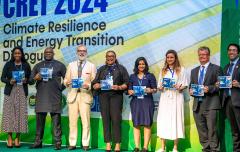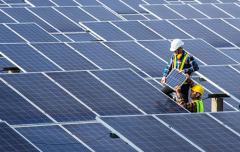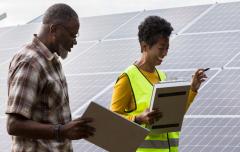Editor's pick: Equality must begin at birth; solar power is the solution
By Yariv Cohen
This article was first published on pv magazine
Solar energy has many strengths, and impactful characteristics witnessed at varying levels around the world. While homes and industries in the western sphere are using solar power to diversify their current energy sources and add some renewable to their existing mix, families and entire communities across Africa are using much smaller solar systems to get electricity in their homes for the first time. That vast gap is noticeable in every aspect of life, including education, income, health, and more. Solar energy already has life-changing effects when looking to bridge gaps between developed and developing countries.
In light of women's week 2022, I want to focus on equality, which takes various shapes and sizes and differs significantly between the developed and the developing world.
It starts with the most natural thing that a woman can do – give birth. While women across Europe, America, and Asia usually deliver in well-lit rooms, with proper equipment at hand and a staff of trained medical professionals, women in sub-Saharan Africa, the poorest region globally, have a very different experience. Maternal health refers to women's health during pregnancy, childbirth, and the postpartum period, and maternal mortality refers to the death of a woman due to causes related to or aggravated by her pregnancy or childbirth.
Maternal mortality, which historically affected all of society, has long been eradicated from developed parts of the world. Yet it continues in developing regions, and most notably in sub-Saharan Africa. Today, almost all (99%) of maternal deaths occur in developing countries, and 68% occur in Sub-Saharan Africa alone, according to The Trends in Maternal Mortality report. The publication, a joint effort by WHO, UNICEF, UNFPA, World Bank Group, and the United Nations Population Division, showcases huge global health disparities that leave African mothers extremely vulnerable.
Despite vast progress being made during the past two decades, statistics are bleak. Sub-Saharan Africans suffer from the highest maternal mortality ratio – 533 maternal deaths per 100,000 live births – and 200,000 maternal deaths a year. And for every maternal death, and for every woman who dies, approximately 20 others suffer serious injuries, infections, or disabilities. The numbers show significant disparities between the richest and poorest countries; the lifetime risk of maternal death in high-income countries is 1 in 5,400, compared to 1 in 45 in low-income countries.
The significant disparities of maternal care are hurting more than global equality. According to the UN, maternal deaths slow economic growth and lead to some $15 billion global productivity losses each year. Alongside the losses, investing in improved health for women and babies has far-reaching benefits for nations. For example, between one-third and one-half of Asia's economic growth from 1965 to 1990 has been attributed to improvements in reproductive. Providing women with a good pregnancy and birthing scenario is crucial in every aspect.
Solar power is changing lives, starting at birth
Most maternal deaths can be prevented through access to skilled health personnel, proper facilities, equipment, and supplies. Many women who experience maternal death in sub-Saharan Africa live in extreme poverty conditions and do not receive adequate care to address complications. Electricity is a big part of the inadequacy.
Across sub-Saharan Africa, 600 million people, 300 million women, have access to only 98,000 health clinics, and from those, only 28% have electricity, according to McKinsey. Without electricity, the most basic infrastructure a clinic can have, women in rural areas give birth in dark rooms, and health workers are sometimes forced to ask pregnant women to cover the charges of candles, something many cannot afford. These women are hindered from any medication or drugs that need cooling and, with big hospitals often days away, have no option to get timely blood tests or ultrasound scans. In the last-mile areas of the SSA region, healthcare personnel are often undertrained, and the lack of proper infrastructure and equipment makes it that much harder for women (and the population in general) of the region to get decent care.
Solar energy has the power to change the gaps of global maternal care and is already impacting millions across the SSA region. Thanks to a growing focus by local governments and a thriving private sector, Africa's solar industry is growing by the day, with healthcare and maternal health specifically addressed by multiple organizations and companies.
Affordable solar systems provide clinics across rural communities with the basic infrastructure they need to begin elevating their healthcare practices. Solar systems can be set up immediately without waiting for expensive transmission lines and other grid infrastructure. They are clean and safe, preventing fire hazards from faulty kerosene lamps or candles.
Depending on their size, solar systems can provide cooling options for vaccines and medication. Through electricity, internet access can be secured, and local teams can consult with global physicians, helping them perform procedures or diagnose specific conditions. Finally, electricity is also an essential enabler of medical equipment that is often crucial in testing and treating various conditions, and in multiple pregnancy and birth-related conditions.
Maternal health should be targeted as the first frontier in reaching global equality, crucial for gender equality. Women everywhere deserve to give birth safely, and solar power is the most affordable, scalable, sustainable solution.
About the author
Yariv Cohen is the co-founder and CEO of Ignite Power, a company providing solar-based, life-enabling, distributed solutions across Africa. Yariv has been a part of the renewable energy sphere for the past two decades, scaling innovation globally to help build a sustainable, inclusive future.
Image credit: JUMEME




